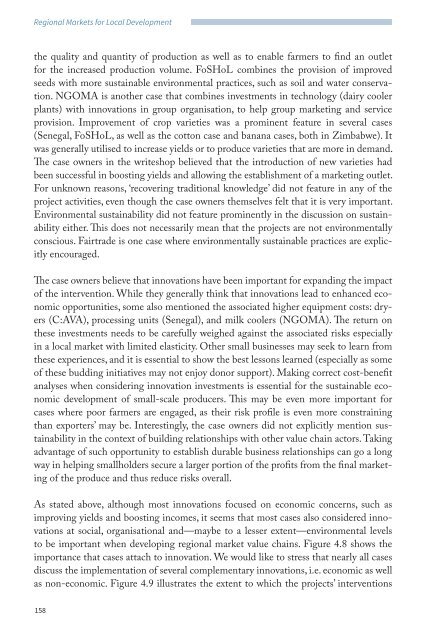Regional Markets
56ec00c44c641_local-markets-book_complete_LR
56ec00c44c641_local-markets-book_complete_LR
You also want an ePaper? Increase the reach of your titles
YUMPU automatically turns print PDFs into web optimized ePapers that Google loves.
<strong>Regional</strong> <strong>Markets</strong> for Local Development<br />
the quality and quantity of production as well as to enable farmers to find an outlet<br />
for the increased production volume. FoSHoL combines the provision of improved<br />
seeds with more sustainable environmental practices, such as soil and water conservation.<br />
NGOMA is another case that combines investments in technology (dairy cooler<br />
plants) with innovations in group organisation, to help group marketing and service<br />
provision. Improvement of crop varieties was a prominent feature in several cases<br />
(Senegal, FoSHoL, as well as the cotton case and banana cases, both in Zimbabwe). It<br />
was generally utilised to increase yields or to produce varieties that are more in demand.<br />
The case owners in the writeshop believed that the introduction of new varieties had<br />
been successful in boosting yields and allowing the establishment of a marketing outlet.<br />
For unknown reasons, ‘recovering traditional knowledge’ did not feature in any of the<br />
project activities, even though the case owners themselves felt that it is very important.<br />
Environmental sustainability did not feature prominently in the discussion on sustainability<br />
either. This does not necessarily mean that the projects are not environmentally<br />
conscious. Fairtrade is one case where environmentally sustainable practices are explicitly<br />
encouraged.<br />
The case owners believe that innovations have been important for expanding the impact<br />
of the intervention. While they generally think that innovations lead to enhanced economic<br />
opportunities, some also mentioned the associated higher equipment costs: dryers<br />
(C:AVA), processing units (Senegal), and milk coolers (NGOMA). The return on<br />
these investments needs to be carefully weighed against the associated risks especially<br />
in a local market with limited elasticity. Other small businesses may seek to learn from<br />
these experiences, and it is essential to show the best lessons learned (especially as some<br />
of these budding initiatives may not enjoy donor support). Making correct cost-benefit<br />
analyses when considering innovation investments is essential for the sustainable economic<br />
development of small-scale producers. This may be even more important for<br />
cases where poor farmers are engaged, as their risk profile is even more constraining<br />
than exporters’ may be. Interestingly, the case owners did not explicitly mention sustainability<br />
in the context of building relationships with other value chain actors. Taking<br />
advantage of such opportunity to establish durable business relationships can go a long<br />
way in helping smallholders secure a larger portion of the profits from the final marketing<br />
of the produce and thus reduce risks overall.<br />
As stated above, although most innovations focused on economic concerns, such as<br />
improving yields and boosting incomes, it seems that most cases also considered innovations<br />
at social, organisational and—maybe to a lesser extent—environmental levels<br />
to be important when developing regional market value chains. Figure 4.8 shows the<br />
importance that cases attach to innovation. We would like to stress that nearly all cases<br />
discuss the implementation of several complementary innovations, i.e. economic as well<br />
as non-economic. Figure 4.9 illustrates the extent to which the projects’ interventions<br />
158


